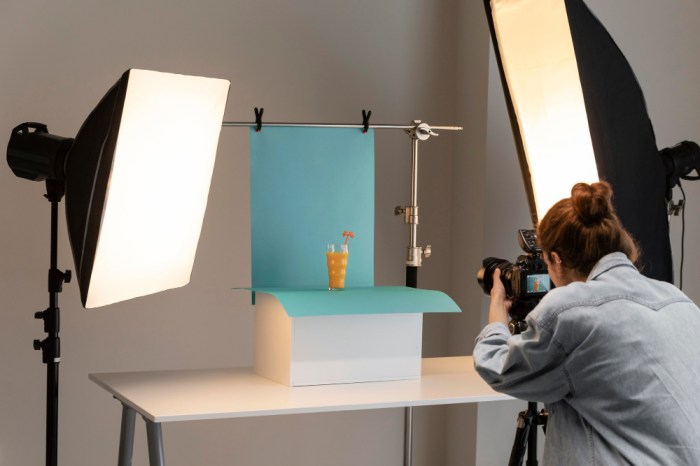E-commerce Product Photography sets the stage for online success, showcasing the art of visual storytelling through captivating images that drive engagement and credibility. Dive into the world of product photography where every shot tells a unique story of quality and style.
Importance of E-commerce Product Photography
In the world of online shopping, high-quality product photography plays a crucial role in driving sales and attracting customers. Visually appealing images can make or break a sale, as they are the first point of contact for potential buyers browsing through numerous products. Let’s delve into why product photography is so vital for e-commerce success.
Enhancing Customer Engagement
When customers visit an online store, they rely heavily on product images to make purchasing decisions. By providing clear, detailed, and aesthetically pleasing photos, businesses can capture the attention of shoppers and keep them engaged. High-quality images not only showcase the product in the best light but also create a sense of trust and transparency, leading to increased customer satisfaction and loyalty.
Building Brand Credibility
Professional product photography not only highlights the quality of the product but also reflects positively on the brand itself. When customers see well-executed images that convey a sense of professionalism and attention to detail, they are more likely to perceive the brand as reputable and trustworthy. This credibility can set a business apart from competitors and establish a strong brand identity in the minds of consumers.
Types of E-commerce Product Photography

From white background product shots to lifestyle product images, various types of e-commerce product photography play a crucial role in showcasing products online.
White Background Product Shots vs. Lifestyle Product Images
White background product shots are clean, simple, and focus solely on the product itself, making it stand out without any distractions. On the other hand, lifestyle product images depict the product in real-life settings or situations, showing how it can be used or integrated into everyday life.
Importance of 360-Degree Product Photography
360-degree product photography allows customers to view the product from all angles, providing a more immersive and interactive shopping experience. This type of photography gives a comprehensive look at the product, helping customers make informed purchasing decisions.
Use of Infographics and Close-Up Shots, E-commerce Product Photography
Infographics in e-commerce product photography can convey complex information in a visually appealing way, making it easier for customers to understand the product features or benefits. Close-up shots focus on specific details of the product, highlighting its quality and craftsmanship, which can attract potential buyers.
Setting Up a Product Photoshoot
When it comes to setting up a product photoshoot for your e-commerce business, attention to detail is key. Follow these steps to ensure your products look their best in photos.
Preparing Products for a Photoshoot
To prepare your products for a photoshoot, start by cleaning them thoroughly to remove any dust or smudges. Arrange them neatly and make sure they are in the best condition possible before shooting.
Equipment Needed for Professional Product Images
Having the right equipment is crucial for capturing professional product images. Here are some essential tools you’ll need:
- A high-quality camera with a macro lens to capture fine details.
- A tripod to ensure stability and prevent blurry photos.
- A white backdrop or lightbox to create a clean, consistent background.
- Reflectors or diffusers to control lighting and reduce harsh shadows.
Lighting Techniques for E-commerce Product Photography
Proper lighting can make a huge difference in how your products appear in photos. Here are some tips for effective lighting:
- Use natural light whenever possible by shooting near a window or outdoors.
- Avoid direct sunlight and instead, opt for soft, diffused light for a more even illumination.
- Consider using artificial lighting like softboxes or LED panels to control the lighting more precisely.
- Experiment with different angles and intensities of light to find the most flattering look for your products.
Editing and Retouching E-commerce Product Images

When it comes to E-commerce product photography, editing and retouching play a crucial role in enhancing the overall quality of product images. Post-processing allows you to make your products look more appealing, professional, and consistent across your online store. Let’s delve into the importance of editing and retouching in E-commerce product photography.
Importance of Post-Processing
Post-processing is essential as it helps to refine and perfect product images to attract potential customers. It allows you to correct any imperfections, adjust lighting, colors, and remove distractions, ultimately making your products stand out and increase sales. Additionally, editing can help maintain a cohesive brand image across all your product photos, establishing a sense of professionalism and reliability.
Common Editing Techniques
- Background Removal: Removing distracting backgrounds and replacing them with a solid color or a more suitable backdrop can help focus the viewer’s attention on the product.
- Color Correction: Adjusting colors, brightness, contrast, and saturation can ensure that product images appear accurate and consistent across different devices.
- Image Cropping: Cropping product images to the right dimensions can improve composition and highlight key features of the product.
- Image Resizing: Resizing images to the correct dimensions for your E-commerce platform can enhance loading speed and overall user experience.
Maintaining Consistent Look
To maintain a consistent look across all product images, consider creating a style guide that Artikels guidelines for editing, such as color schemes, lighting, shadows, and angles. Use presets or templates to apply similar editing settings to all photos, ensuring a uniform appearance. Regularly review and compare edited images to ensure they align with your brand’s aesthetic and standards.
